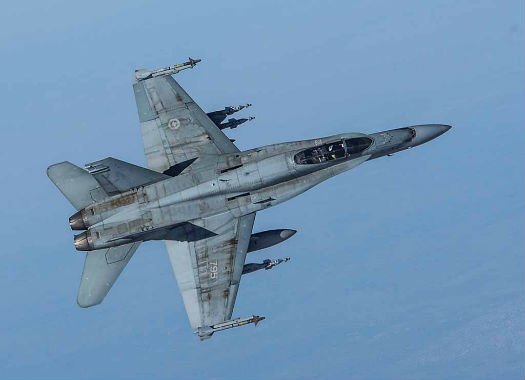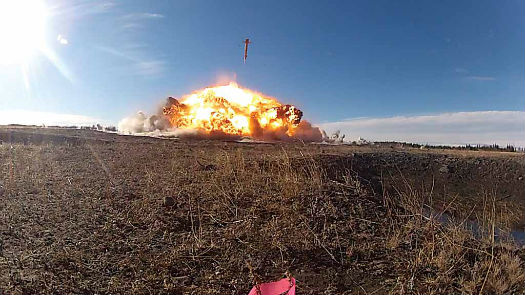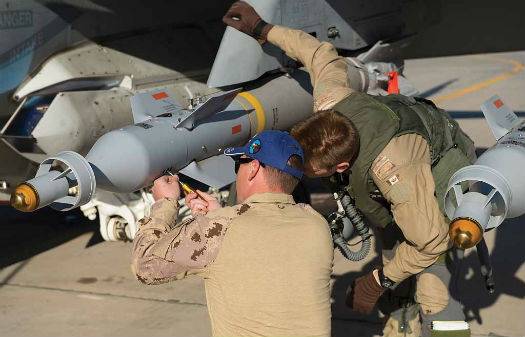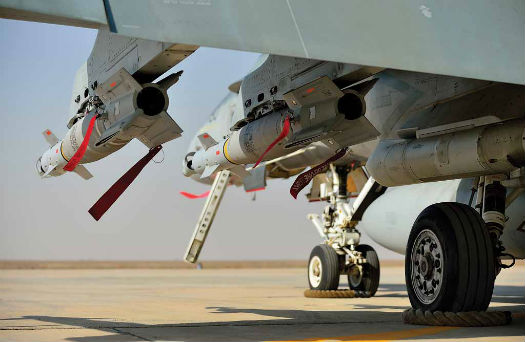A new bomb rack, designated the BRU-55, has been integrated on the CF-18 Hornet. The dual weapon rack (visible in this photo) enables the Hornet to carry twice as many weapons, allowing for even more flexibility in mission response.
As the RCAF’s Boeing CF-188 (CF-18) Hornet fleet enters its 33rd year of service, many assume the aircraft still represents outdated legacy fighter technology—an assumption that actually couldn’t be farther from the truth. While the Hornet’s air frame may indeed be over 30 years old, a constant effort to develop and improve its weapons systems began not long after the aircraft entered service in 1982, and hasn’t stopped since.
The result of this perpetual effort is a weapons system with capabilities that match or exceed many of the most advanced fourth generation fighter aircraft presently employed by Canada’s allies. The responsibility for a large part of that engineering and development work lies with the Aerospace Engineering Test Establishment (AETE), located at 4 Wing Cold Lake in Northern Alberta.
A core element of AETE’s mandate is the testing and evaluation of new equipment, software and weapons systems for the RCAF’s different aircraft fleets. Recently, AETE completed two related projects that have dramatically enhanced the CF-18’s precision guided munition (PGM) capabilities, once again demonstrating the agency’s operational support role and reaffirming the relevance of the RCAF’s fighter force to coalition capability.
“We’re going to new conflicts; new conflicts generate new requirements; new requirements require new gear; and the new gear needs to be integrated and tested to ensure it works correctly and is safe to use,” explained Maj Joshua Kutryk, an AETE test pilot. He recently spoke to Skies about AETE’s latest Hornet flight test projects. The end of 2014 marked the completion of two significant initiatives: a new and significantly improved PGM, as well as a release rack that allows the Hornet to carry two weapons on wing pylons that could previously only carry one.
A GBU-49 Enhanced Paveway II “smart bomb,” caught just moments before following another GBU-49 to a direct hit during testing. AETE Photo
The newly certified weapon is the 500-pound Raytheon Enhanced Paveway II (EP II), designated the GBU-49 (Guided Bomb Unit – 49). In the past, Canadian CF-18s have been certified to employ other PGMs, namely the laser-guided Paveway II series and the GPS-guided Joint Direct Attack Munition (JDAM) weapons, both of which were fundamental to success during Operation Unified Protector in Libya. Laser guidance makes the accuracy of the Paveway II group of weapons remarkable, even providing them with a limited ability to follow moving targets. This accuracy increases the likelihood of their successful deployment in combat, while decreasing the possibility of collateral damage. However, the ability to laser-designate a target from the air can be hindered by weather or other line of sight issues, and GPS-only guidance removes the pilot’s ability to deal with last minute target movements after the weapon is released. Such limitations led to the development of the new Enhanced Paveway II series of weapons, which have added GPS and inertial navigation system (INS) guidance systems, as well as improved overall accuracy. These enhanced weapons can be programmed to use any or all of their guidance systems, as required, to essentially fly a pre-programmed flight profile to the target. “And that’s pretty important for all kinds of tactical reasons,” commented Kutryk. “Sometimes, you can’t see the target so the laser is not going to work; other times, you might not want to rely on GPS for different reasons, so the GBU-49 is a significant improvement because it provides flexible guidance options.”
But, the benefits of using such a weapon actually extend well beyond just its guidance modes. “We can program terminal impact data, so we can actually tell the weapon how we want it to arrive at the target,” continued Kutryk. “We dictate the energy state of the bomb at impact, and the weapon will fly a profile to achieve it. The weapon also provides a significant increase in possible aircraft range from the target at release.”
A CF-18 Hornet pilot and 409 Tactical Fighter Squadron technician confirm the settings on a Paveway II bomb prior to mission launch.
All such factors contributed to the RCAF’s selection of the EP II.
In many cases, the RCAF chooses to parallel development decisions made by the U.S. Navy for its fleet of F-18 aircraft. In the case of selecting an advanced precision guided munition, however, Canada chose not to follow the U.S. Navy. Rather, the GBU-49 was integrated on the CF-18 as a purely RCAF effort.
In conjunction with the GBU-49 project, a related initiative to integrate a new bomb rack, designated the BRU-55, was also undertaken. The integration of the new BRU-55 dual weapon rack enables the Hornet to carry twice as many weapons, providing commanders and pilots with the ability to respond to twice as many situations that may arise during a mission.
The flight test projects AETE is assigned span all the aircraft fleets of the RCAF. Just a few examples of the many and varied test projects AETE is working on include a new GPS-based flight management system for the Hornet; real time satellite-enabled video streaming for the Lockheed CP-140M Aurora; flight testing of the new Cyclone maritime helicopter; and testing of helicopter GPS-based precision approaches to moving targets such as ships. AETE manages and executes these projects with its team of over 200 personnel located at 4 Wing Cold Lake in Alberta, and at other satellite facilities in Canada and abroad. The AETE team includes specialists in fields such as aircraft design, aerodynamics, maintenance, armament, airborne data systems, image data systems, flight test instrumentation, and flight test evaluation.
The addition of the BRU-55 dual weapon rack for the Hornet has doubled its capacity to carry certified weapons from two per wing to four.
Prioritization of AETE’s work is directed by 1 Canadian Air Division based on its evaluation of the Department of National Defence’s current requirements. Last fall, after years of work had already been undertaken on the BRU-55 and GBU-49 projects, AETE was directed to make these items a top priority, and the team began the final effort to complete them.
The resulting flight test program was comprehensive, with mission computer software code playing a central role. Software needed to be written allowing the pilot to program the intended behaviour for the weapon, and that same software had to communicate with the weapon in a language that the weapon understood. Evaluation of the “user interface” through which the pilot could quickly and accurately program the weapon was also a critical component.
Once written, the code needed to be debugged and tested to ensure not only that it was working as designed, but also to verify that it didn’t have any unexpected effects on normal aircraft functionality. In the same way the CF-18 can’t be flown without fuel or a pilot, it can’t be flown without functioning software, and a large amount of AETE’s ongoing Hornet support is devoted to what’s called regression testing. This testing aims to prove that integration changes haven’t corrupted the integrity of the aircraft’s baseline software.
“We’re constantly upgrading the airplane’s software. It’s like a desktop computer operating system—it is always being improved upon, and every time we do that we have to go back to ground zero to prove the airworthiness of the aircraft itself,” said Capt Martin Dionne, an AETE Flight Test Engineer.
The wire harness cover that runs down the side of the bomb carried by Hornet AC#751 identifies it as an Enhanced Paveway II precision guided munition. AETE completed certification of the weapon at the end of 2014, after extensive work and testing to integrate its capabilities to the Hornet.
Similarly, there is always a hardware component to such projects. In the case of the EP II and BRU-55, testing was done to prove that the aircraft, rack and weapon are safe together as a system. Proving that the pieces integrate together encompasses many different areas: electrical connections and capacities; mechanical fit of the rack to the airplane; and aerodynamic changes to the way air flows around the aircraft, to name just a few. Testing involves investigating that the weapon is safe to load onto the aircraft; that it properly separates from the aircraft when dropped or jettisoned; and that it behaves as it was programmed to during its flight to the target.
The testing required to integrate a new weapon alone is significant enough, but the matrix of configurations that needs to be investigated grows significantly when you consider all the possible configurations involved with the integration of the BRU-55 rack as well. Many different operational possibilities were considered and tested to ensure the addition of the rack and weapon was safe for use in the field.
Determining how the EP II weapon system and BRU-55 now available for the Hornet will actually be used, on the other hand, is beyond AETE’s mandate. Responsibility for that falls to the RCAF’s operational pilots and their leaders, all of whom are surely eager to develop the tactics that will fully utilize the capabilities of this new equipment.
While a replacement for the CF-18 is still undecided, the RCAF will no doubt continue to direct AETE to undertake projects like these, thereby ensuring that its fighter force can continue to contribute effectively to future allied operations.









